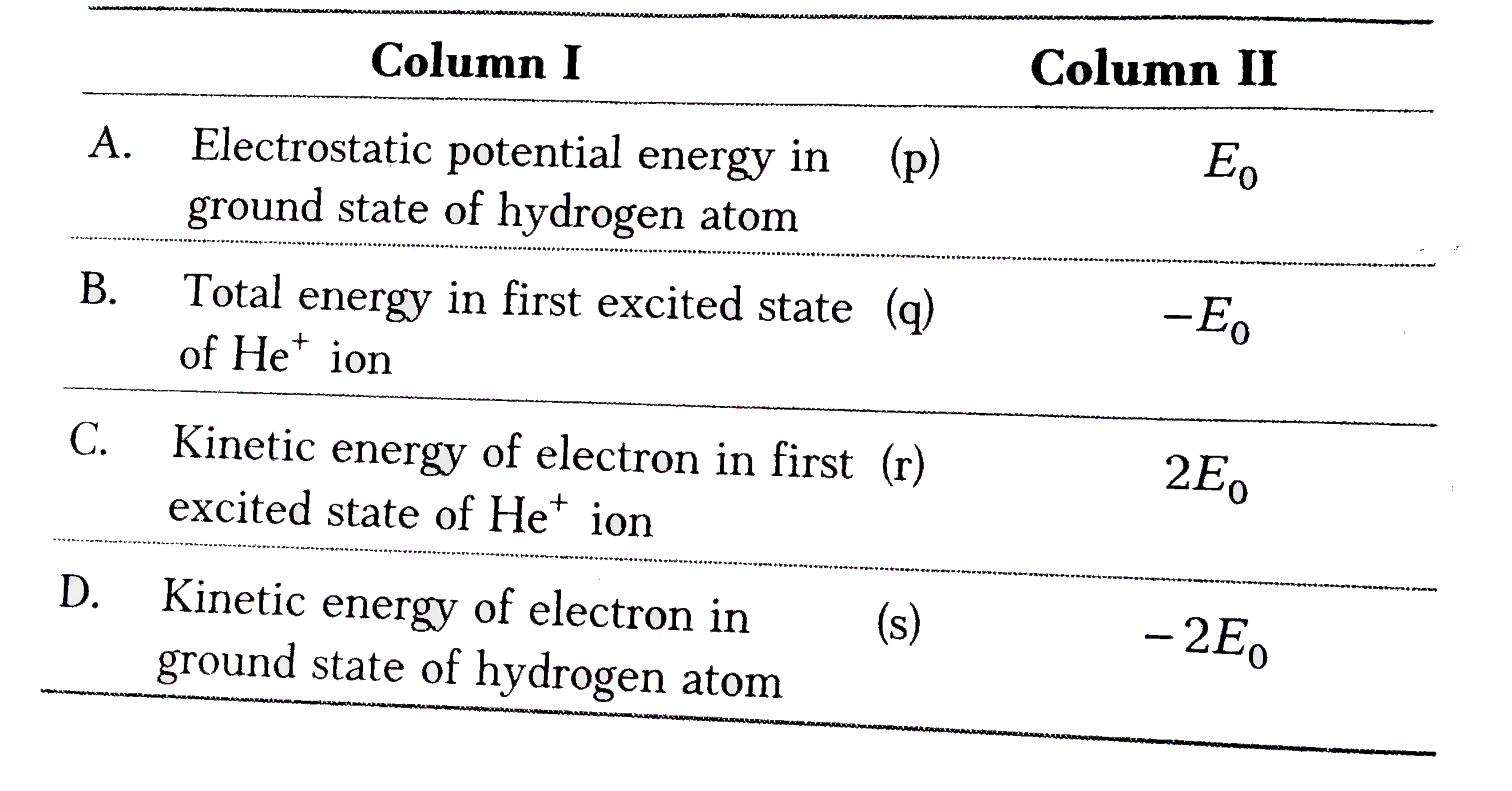Ground state energy of H-atom is (−E1),t he velocity of photoelectrons emitted when photon of energy E2 strikes stationary Li2+ ion in ground state will be:
(a) v=√2(Ep−E)m
(b) v=√2(Ep+9E)m
(c) v=√2(Ep−9E)m
(d) v=√2(Ep−3E)m
The correct Answer is:C
To solve the problem step by step, we need to find the velocity of photoelectrons emitted when a photon of energy E2 strikes a stationary Li2+ ion in its ground state.
Step 1: Determine the ground state energy of Li2+
The ground state energy of a hydrogen-like atom can be calculated using the formula:
En=−Z2⋅E1n2
where:
- Z is the atomic number (for lithium, Z=3),
- E1 is the ground state energy of hydrogen (E1=13.6eV),
- n is the principal quantum number (for ground state, n=1).
Substituting the values:
ELi2+=−32⋅13.612=−9⋅13.61=−122.4eV
Step 2: Calculate the kinetic energy of emitted photoelectrons
When a photon of energy E2 strikes the Li2+ ion, the energy absorbed by the ion is used to overcome the ion's binding energy and the remaining energy is converted into kinetic energy of the emitted photoelectrons.
The kinetic energy (KE) of the emitted photoelectrons can be expressed as:
KE=E2−ELi2+
Substituting the energy of Li2+:
KE=E2−(−122.4)=E2+122.4
Step 3: Relate kinetic energy to velocity
The kinetic energy of the emitted photoelectrons can also be expressed in terms of their velocity v:
KE=12mv2
where m is the mass of the electron. Setting the two expressions for kinetic energy equal gives:
E2+122.4=12mv2
Step 4: Solve for velocity v
Rearranging the equation to solve for v:
v2=2(E2+122.4)m
Taking the square root:
v=√2(E2+122.4)m
Final Expression
Thus, the velocity of the photoelectrons emitted when a photon of energy E2 strikes the stationary Li2+ ion in the ground state is given by:
v=√2(E2+122.4)m
- Z is the atomic number (for lithium, Z=3),
- E1 is the ground state energy of hydrogen (E1=13.6eV),
- n is the principal quantum number (for ground state, n=1).
Topper's Solved these Questions
- ATOMIC STUCTUREBOOK - NARENDRA AWASTHI ENGLISHCHAPTER - ATOMIC STUCTUREEXERCISE - Level 3 (Passage 1)
3 Videos
- ATOMIC STUCTUREBOOK - NARENDRA AWASTHI ENGLISHCHAPTER - ATOMIC STUCTUREEXERCISE - Level 3 (Passage 2)
4 Videos
- ATOMIC STUCTUREBOOK - NARENDRA AWASTHI ENGLISHCHAPTER - ATOMIC STUCTUREEXERCISE - Subjective problems
1 Video
- CHEMICAL EQUILIBRIUMBOOK - NARENDRA AWASTHI ENGLISHCHAPTER - CHEMICAL EQUILIBRIUMEXERCISE - Match the column
1 Video
Similar Questions
Knowledge Check
The ground state energy of hydrogen atom is -13.6eV. What is the K.E. of electron in this state?
A2.18×10−14JB2.18×10−16JC2.18×10−18JD2.18×10−19JThe ground state energy of an atom is −13.6eV. The photon emitted during the transition of electron from n=3 to n=1 state, is incidenet on a photosensitive material of unknown work function. The photoelectrons are emitted from the materials with a maximum kinetic energy of 9 eV. the threshold wavelength of the material used is
A0.9×10−7mB4×10−7mC0.47×10−7mD9×10−7m
Find the velocity of photoelectrons liberated by electromagnetic radiation of wavelength λ=18.0nm from stationary He+ ions in the ground state.
View SolutionWhat is the energy of the electron in He+ ion in the ground state ?
View SolutionThe ratio of energies of first excited state of He+ ion and ground state of H−atom is
View SolutionThe ground state energy of hydrogen atom is −13.6eV. The energy of second excited state of He+ ion in eV is
View SolutionGround state energy of H-atom is -13.6 eV. The energy needed to ionise H-atom from its second excited state is
View SolutionThe energy of an atom (or ion) in the ground state is −54.4eV .It may be?
View Solution
